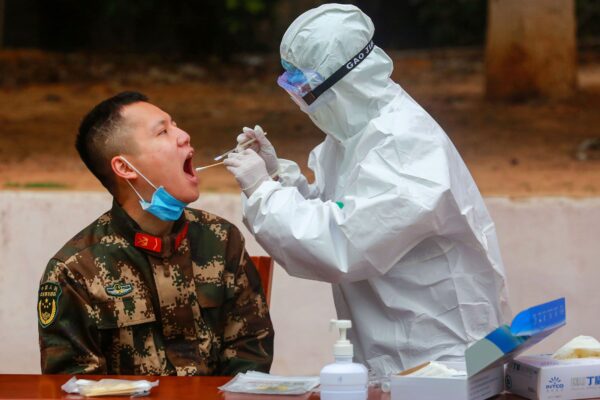Book Excerpt (published in The Epoch Times) From COVID-19: The Politics of a Pandemic Moral Panic
Timelines associated with the spread of COVID-19 have changed over the past several months and, with new information, may change again in the future. There seems to be widespread agreement in publicly available sources that individuals with odd flu-like illnesses were observed in China as early as August 2019. Nothing was confirmed until a 70-year-old man with Alzheimer’s disease was diagnosed in late December 2019 in Wuhan. According to the Lancet, which, despite recent irregularities, remains a flagship English-language general medical journal, the symptoms of this first patient presented around Dec. 1, 2019. There also seems to be agreement that by late 2019 the “novel” coronavirus had jumped from an animal to a human being; this is called a zoonotic transmission. At this point, narrative agreement breaks down. Some observers said the transmission from an animal, not yet specified, to a human took place in the Huanan Wholesale Seafood Market, also in Wuhan. It was called a “wet” market not simply because it sold slaughtered live seafood that requires water to live. It was also the site of the live slaughter of pangolins, wolf pups, hares, snakes, raccoon dogs, porcupines, badgers, pigs, chickens, and peacocks.
A second narrative began with the infection of the wife of the patient with Alzheimer’s who showed symptoms of pneumonia at the end of the first week in December. She was then hospitalized in an isolation ward. She had no known history of exposure to the Wuhan wet market. Some observers then turned their attention to the Wuhan Institute of Virology, some 12 kilometres away from the market. Others looked at the even closer (280 metres) Wuhan Centre for Disease Control and Prevention. The Wuhan virology lab, which happens to have close ties to the National Microbiology Laboratory in Winnipeg, was built by a contractor for the People’s Liberation Army and is associated with the Academy of Military Medical Sciences. It was intended to be a top-level security laboratory (as well as a top-secret one) that would be capable of handling safely the deadliest human pathogens. The Chinese certified it as meeting Biosafety Level Four, the highest security rating available, but many scientists outside China viewed this information skeptically. In 2017, an article in Nature raised questions about the safety protocols in Chinese microbiology labs, adding historical weight to the possibility that the virus may have escaped from the Institute of Virology into the human population that frequented the market.
In January 2018, the United States sent scientists with diplomatic status to visit the Hunan virology lab. They discovered that SARS-like coronaviruses from bats could interact with the human receptor for SARS coronavirus, which “strongly suggests that SARS-like coronaviruses from bats can be transmitted to humans to cause SARS-like diseases.” The Americans also found that the lab personnel did not follow or practice Level Four security protocols but were closer to Level Two.
The Institute of Virology was controversial for another reason. Virologist Shi Zhengli was nicknamed the “bat lady” for directing a team that had accumulated an extensive collection of coronaviruses from the bat caves of southern China. She has also conducted experiments on bat viruses “to find out how they might mutate to become more infectious to humans.” These experiments are called “gain-of-function” or GoF experiments. As the name implies, they are intended to generate viruses that may be more pathogenic and/or transmissible than wild viruses or even to generate viruses with attributes that do not exist in nature. That such experimentation is controversial is an understatement. For that reason, the United States has banned GoF experiments from time to time and they have not been conducted in the Winnipeg lab. They were reinstated in the U.S. on Dec. 19, 2017 after having been discontinued since October 2014.

Shi provided a different account. For context, two matters should be borne in mind. First, the Wuhan Institute has been studying bats and bat diseases for a quarter-century. At the time, they were concerned with discovering the origins of SARS-1. It turned out that the cross-species infection from bats to humans was discovered relatively early. The Chinese scientists eventually traced the origin of the SARS-1 virus to a cave in Yunnan province, over 1,200 kilometres south of Wuhan. The nearest relative to SARS-CoV-2 is also a coronavirus that the Wuhan lab isolated from a horseshoe bat found in Yunnan in 2013. This virus, then called RaTG13, shared 96.4 percent of its genome with SARS-CoV-2. The 3.8 percent of genetic difference is equivalent to between 20 and 50 years of natural evolutionary change. But, as we shall see, that is not the whole story. In any event, how a bat in Yunnan led to an infection in Wuhan has yet to be definitively accounted for. The second contextual factor is the adversarial geopolitical relationship between the United States and China. Specifically, Shi said that President Donald Trump “owed us an apology” for suggesting that SARS-CoV-2 escaped from the Wuhan lab.
On July 15, 2020, Shi emailed Science with a reply to a series of written questions. When asked if a bat “in or close to Wuhan” might have infected someone, she said that she favoured the theory that the virus spread through an intermediate host. She did not speculate on what that host might be, but others have mentioned pangolins, which are found in southern China, are also smuggled into China from Southeast Asia, and are sold for food and traditional medicine in the Wuhan wet market. Nor did she indicate whether any zoonotic transmission took place in Wuhan or elsewhere. She did, however, repeat the observation of an Australian expert on virus evolution noted above, that the divergence in genome sequence between SARS-CoV-2 and RaTG13 was between 20 and 50 years of natural evolution.
However, as just noted, that was not the whole story. Both Shi and the American Defense Intelligence Agency (ADIA) said that the SARS-CoV-2 virus was not genetically engineered. The Americans also said that there was “no credible evidence” that the virus was intentionally released as a biological weapon. The Wuhan lab was, however, capable of conducting cut-and-paste genetic engineering experiments and evidently, in 2015, took a piece of SARS-1 virus and replaced it with a piece from a SARS-like bat virus to make it infectious for humans. However, such changes are easily detectable, “like a contemporary addition to an old Victorian house.” The Americans’ conclusion, that it was not intentionally released is, obviously, speculative: that there was no evidence of such an action is not evidence of the absence of action. That the Chinese denied doing so was entirely to be expected.
There remains yet another problem: about a third of the original cluster of Wuhan cases had no exposure to the wet market, which meant that COVID-19 was already spreading through inter-human contact. Here is where the circumstantial evidence regarding the Wuhan Institute of Virology needs to be considered. First, as part of an international program, partly funded by the United States, the institute had been undertaking GoF research. As noted, such research is controversial, especially when conducted in labs with less than stellar safety records, including those in the U.S.
One explanation involves the technique used in GoF experiments often called “animal passage.” In 2010, a Dutch virologist, Ron Fouchier, was working on a flu virus called H5N1. It was mainly transmitted by humans handling infected birds and was often lethal. Fouchier wondered what it would take to change H5N1 into a virus more easily transmissible among humans and conducted his GoF experiment using ferrets, not cell cultures, to mutate H5N1. Ferrets are, with respect to viruses, genetically close enough to humans so that if a mutated H5N1 virus could be transmitted between infected and uninfected ferrets, the same thing would likely be possible between humans. The mutation occurs naturally in the ferret’s body: infect the first animal with pure H5N1, wait till it gets sick, and then infect a second one with a nasal swab, then a third, and so on. With each iteration, the genetic content of the virus is slightly changed. After the 10th iteration of the animal passage, Fouchier observed that an infected animal could transmit the virus to another one in an adjoining cage and not through a direct swab. Animal-passage techniques employed in a GoF experiment, again to state the obvious, can eventually produce a novel and, for that reason alone, a dangerous virus.
Fouchier claimed the GoF experiment was essential to demonstrate causal relations among genes, mutations, and disease. Thus, it was useful for the preparation of future anti-viral medicines. For whatever reason, by 2020 animal-passage GoF experiments had become both widespread and routine; most were conducted in BSL-4 labs, though Fouchier’s was rated at BSL-2. According to Colin Carlson, an expert in emerging infectious diseases at Georgetown University, such GoF experiments helped virologists isolate and classify SARS-CoV-2 shortly after it appeared. Others, notably Richard Ebright at Rutgers, disagreed. Granted, animal-passage GoF experiments, like so many other technical activities, have dual uses. In terms of the accumulation of circumstantial evidence of such GoF activity in the Wuhan lab, however, the important thing is that, compared to cut-and-paste genetic engineering, animal passage experiments are much more difficult to detect. To revert to the Newsweek image, they are like new Victorian replica additions to an old Victorian house.

Consequently, animal-passage techniques results are often indistinguishable from the evolution of a virus in the wild. A bat-sourced coronavirus passing thorough 10 ferrets would be difficult, to say the least, to distinguish from a naturally evolved one. It’s possible that the Wuhan lab never undertook animal-passage GoF experiments, though this seems highly unlikely. More credible is the notion that such experiments were routinely but secretly conducted. Perhaps more interesting is another consideration. Kristian Andersen of Scripps Research published a widely cited account in Nature Medicine that argued “that SARS-CoV-2 is not a laboratory construct of purposefully manipulated virus.” The authors went on to discuss “two scenarios that can plausibly explain the origin of SARS-CoV-2.” The second, natural selection in humans following a zoonotic transfer, is less significant than natural selection from an animal host prior to a zoonotic transfer.
The authors do admit that “in theory, it is possible that SARS-CoV-2 acquired … mutations … during adaptation to passage in cell culture,” but the evidence of SARS-CoV-2-like viruses in pangolins “provided a much stronger and more parsimonious explanation” of how SARS-CoV-2 acquired its new transmissibility features, namely inter-human infection. The authors did not consider the possibility of animal passage in a laboratory. But as Ebright noted in an email to Newsweek, mutation in a laboratory using animal-passage GoF techniques is “identical apart from location” and human intervention, from wild “pangolin-passage” scenarios. Ebright thus concluded that Andersen’s reasoning was “unsound” because there was no reason to favour wild-pangolin over other laboratory-based animal-passage events.
To summarize: the Wuhan Institute of Virology was in possession of the virus RaTG13, which shared 96.4 percent of its genetic material with SARS-CoV-2. A 3.8 percent genetic divergence may provide a challenge to an animal-passage bridge, but it would be far more likely than a natural evolutionary series of mutations. Second, the denials Shi published in response to questions Cohen raised in Science were, as Ebright said, “formulaic, almost robotic, reiterations of statements previously made by Chinese authorities and state media.”
Accordingly, they should be given the same validity as bestowed upon Chinese authorities and state media.
Indeed, politics as much as science has informed any accounts of the origin of the SARS-CoV-2 virus that cast the slightest doubt on the official Chinese version.

